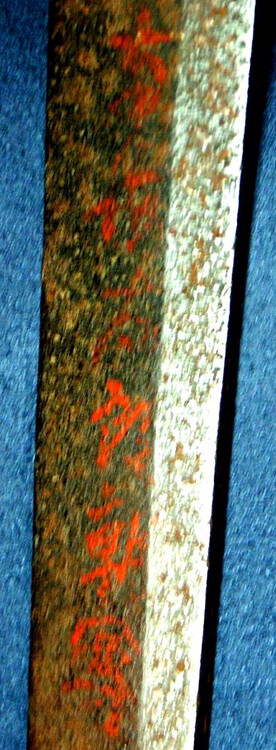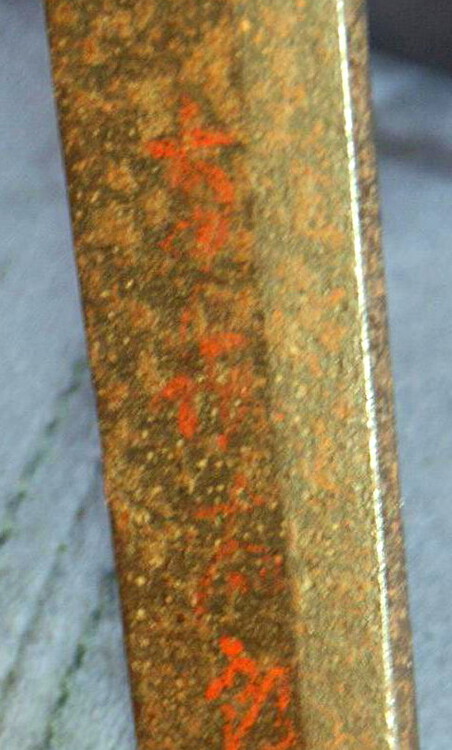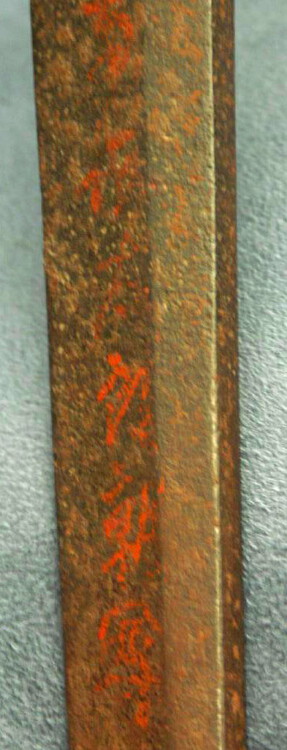-
Posts
4,123 -
Joined
-
Last visited
-
Days Won
31
Everything posted by Grey Doffin
-
Hi guys, 6 Kanji I think, the 5th might be Kane. Can you tell me what this says? The 1st picture, which you may have to click to open, is probably the best. I've played with color and saturation to make it more readable; this isn't the real look of the nakago. And the sword will be for sale, if anyone cares about that. Thanks, Grey
-
Hi Charlie, The 1st Kanji in Idzumi is partially missing, but not so much that it is unreadable. With practice you'll recognize the Kanji; it's not that difficult. You need a set of my flashcards (if I may be so brazen). The Kanji were chosen to be relevant to sword signatures, they are written, not print, so they more closely match what you find on swords, and no other way I know of will teach you as quickly. Grey
-
Idzumi no Kami Kanesada. Grey
-

Kasumi do.....polishing question
Grey Doffin replied to undermilkwood's topic in General Nihonto Related Discussion
Hi Joe, I realized when I clicked on "Submit" that you might take offense with my posting, but the point I was trying to make called for clarity, not diplomacy. This is a forum about Nihonto; I assumed that was what you were getting at. Had you said upfront that you planned to polish blades you make I wouldn't have answered; you can do to them as you like. Any case, sorry for my share of the misunderstanding. Grey -

Kasumi do.....polishing question
Grey Doffin replied to undermilkwood's topic in General Nihonto Related Discussion
If someone has proper training to polish Nihonto he will know which stones to use and when to use them. If he doesn't have proper training he should leave polishing to those who do. Grey -

Advice on a sword for a newbie.
Grey Doffin replied to Chopstick's topic in Military Swords of Japan
Which means that if you use it to cut (tameshigiri), you might get seriously injured when the blade shatters on impact. Grey -

Help to remove the blade from the koshirae
Grey Doffin replied to Dave0258's topic in Military Swords of Japan
Dave, 1st make sure that there isn't a 2nd mekugi further down the tsuka. If not, and if we're dealing with gunto koshirae with cast tsuba or koshirae with an iron tsuba without soft metal inlay, the following technique should work easy and should do no damage. Fold a bath towel in thirds lengthwise and lay it on a counter with about 6' of the towel hanging over the edge. Lay the side of the blade on the towel with the tsuka hanging over the edge (if there is a spring clip through the tsuba use the other side of the blade on the towel). Now bring the tsuka forward so the tsuba bumps into the towel and counter edge. It might take a few bumps and you might have to gradually increase force, but very soon the blade will break lose from its accumulated rust and start to exit the tsuka. It is never necessary to remove the sarute. Once again, don't use this technique with soft metal koshirae; it could suffer damage. Hope this helps, Grey -
Hi Markus, The signature on your sword doesn't match the signatures for the well known Umetada Shigeyoshi in Fujishiro and Nihonto Zuikan (the 2 references I've checked). According to Hawleys there was a 2nd smith who might have signed this way but I have no references for his work. Rice glue is the only option for fixing the saya. I hesitate to tell you how to use it because your question about using nails to fix it tells me that you have no experience with wood work. It's better that the saya stay as is than to be glued improperly. Is there someone who works on sayas you could send it to for repair? Hope this helps. Grey
-
Umetada Shigeyoshi. 17th century if the signature is right. No nails on the scabbard. It needs to be properly reglued with rice glue; anything else is forbidden. Grey
-

Shin-Gunto Sword from WWII
Grey Doffin replied to keywestbabe's topic in General Nihonto Related Discussion
Hi Karen, No one here will be able to help you unless we can see some pictures of your sword: the mounts, the blade, and the tang of the blade. Then it should be obvious if it's real or not. Grey -

Is it worth it to restore an old military sword - redux
Grey Doffin replied to Dave0258's topic in Military Swords of Japan
And continue to store the blade in its koshirae. Even in less than ideal condition, the koshirae provide the best protection. Grey -
Hi Charlie, Here's a quick, easy, and totally reversible method to temporarily fix the saya. You will need masking tape and white paper. Cut a strip of paper about a half inch wider than the tape and long enough to go around the saya about 1 1/2 times. Wrap the paper around the saya below where you want it to be, and tightly wrap the paper with the tape. Now push the tape/paper up towards the top of the saya (koi-guchi). Since the diameter of a saya increases as you approach the koi-guchi, as you push the paper up it will tighten. You might have to try a time or 3 before you get it right and maybe you'll want a 2nd paper/tape below the top one, but once in place the saya will be as tight as when new. What's more, since the tape isn't touching the saya no damage will be done; the paper can be slid back down when necessary and it won't leave a mark. I do this to shira-saya whenever I ship a sword, whether the saya's split or not, just as insurance against a split developing due to a bump in transit. You can do a permanent fix of the saya with rice glue if you know how, but this is probably best left to someone with experience fixing sayas. Whatever you do, do not use any other type of glue. Grey
-

Opinions on this smallish wakizashi
Grey Doffin replied to firebee1976's topic in General Nihonto Related Discussion
I agree totally. Often the mounts are bone gussied up to look like old ivory, but even if ivory they are almost always dock work (sold near the dock to sell to departing tourists). Grey -
That method works well if you have to ship a bare blade. Be sure that no tape touches the blade anywhere (always have paper between the tape and blade, even the nakago) and that the wire is insulated (as shown) so the metal of the wire doesn't touch the nakago. However, you should never ship a blade bare if it has koshirae. Koshirae does the best job of protecting the blade in transit and once the blade arrives where it's going it has its koshirae to protect it as well. Make sure there is a mekugi through the hole in the tsuka, otherwise the blade can crash down inside the saya and shatter its point if the package is dropped. In fact, unless the blade is unmounted for viewing or something else, there should always be a mekugi in the ana. Carpet tubes work very well for shipping Nihonto; free at any carpet store. I make caps of cardboard: a round hub and 4 spokes to fold down over the sides of the tube. These tubes are incredibly strong and since they're round, not much gets stacked on top of them in transit. And while I'm on the subject, one last shipping problem is a sword with saya and no tsuka. The blade should never be shipped in just the saya, as there is no mekugi to keep the kissaki away from the saya bottom. 2 options here: The 1st is to cut 2 blocks of wood with holes placed through them to correspond to the mekugi ana. A stout, insulated wire is threaded through the blocks and nakago and tied tightly. The blocks serve the same purpose as the tsuka. The 2nd option is to completely cover the blade in quite a few layers of newsprint and tape, making sure that the paper is wrapped around both ends of the blade. Wrap the saya in a few layers of newsprint and tape. Now securely tape the blade to the saya, with the kissaki above the bottom of the saya, and you're ready to pack. Anyone have better ideas? Grey
-
Do occupation swords, made by Chinese slaves at the direction of Japanese masters, actually exist? I've always thought this to be a story made up by sellers of fakes to dupe the unsuspecting. Grey
-
Gary, I said that, since there are no references with which to compare the mei, you need to look at the blade and decide if it is Bizen. If so it likely is what it says: Norihisa. Only if the blade isn't right for Sue-Koto Bizen do you need to consider the possibility of gimei. OK? Grey
-
Gary, It is actually quite common to see a gimei of an unknown smith. Think about it: if you're doing a fake of Kotetsu your customers have tons of references to check; if you're faking a smith who doesn't appear in a reference... I've seen a few blades I was convinced were Gunto, but with signatures of unknowns from centuries earlier. About the gimei Hizen blades that paper to the smith in the gimei after the mei is removed: this also makes perfect sense. A judgment that a signature is faked doesn't say anything about the work on the blade, only about the signature. Many gimei were probably originally meant as attributions, not as trickery. Still, the shinsa team can't certify the work separate from the signature; the fake has to be removed. Grey
-
Gary, I checked my "Index of Japanese Sword Literature" and the only Norihisa that made it into any of the 63 included references was a Gendai smith. The index includes all the standard, and quite a few obscure, references so it isn't likely that anyone will be able to help you with a book. Since the few Norihisa smiths listed in Hawleys that might have signed katana mei before Gendai times are all from Bizen, you need to decide if this sword is a Bizen blade. If so, it is likely one of those smiths but you won't get further information on just which one. If not, then it is most likely gi-mei. Hope this helps. Grey
-
Hi Peter, Unless the junk box was given to a dealer in Japan who sells questionable tsuba, I think we can assume that your tsuba is cast. This sale just popped up on ebay: http://cgi.ebay.com/Imperial-Japanese-S ... 0142853644 Grey
-
That would make the hi (grooves) ato-bori: carved later. In this case the hi post date the shortening. Grey
-
It looks like the nakago around the mei has been partially cleaned. If this is the case and you know who did it, tell him never to do that again. Grey
-
Yoshitsugu, I believe, and Showa Ju Ku Nen Hachi Gatsu, I'm sure. August of 1944. Grey
-
Looks to be a typical Shinto woman's naginata, least that's what I've heard them called. The hi, as you point out, is poorly done, the grain is coarse, and the nakago looks messed with (what's with the vertical marks and that circular spot below the machi looks suspicious). Doesn't look very interesting to me. Grey




